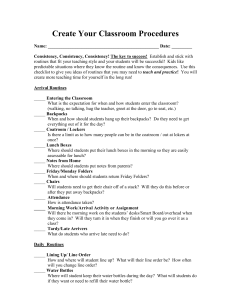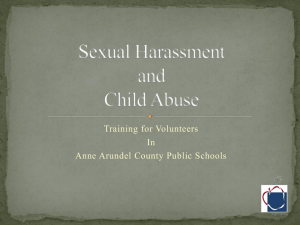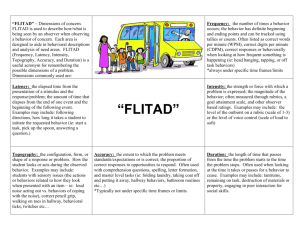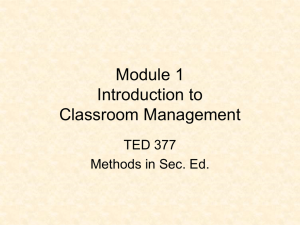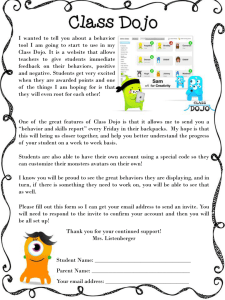Examples of Classroom Managed vs
advertisement
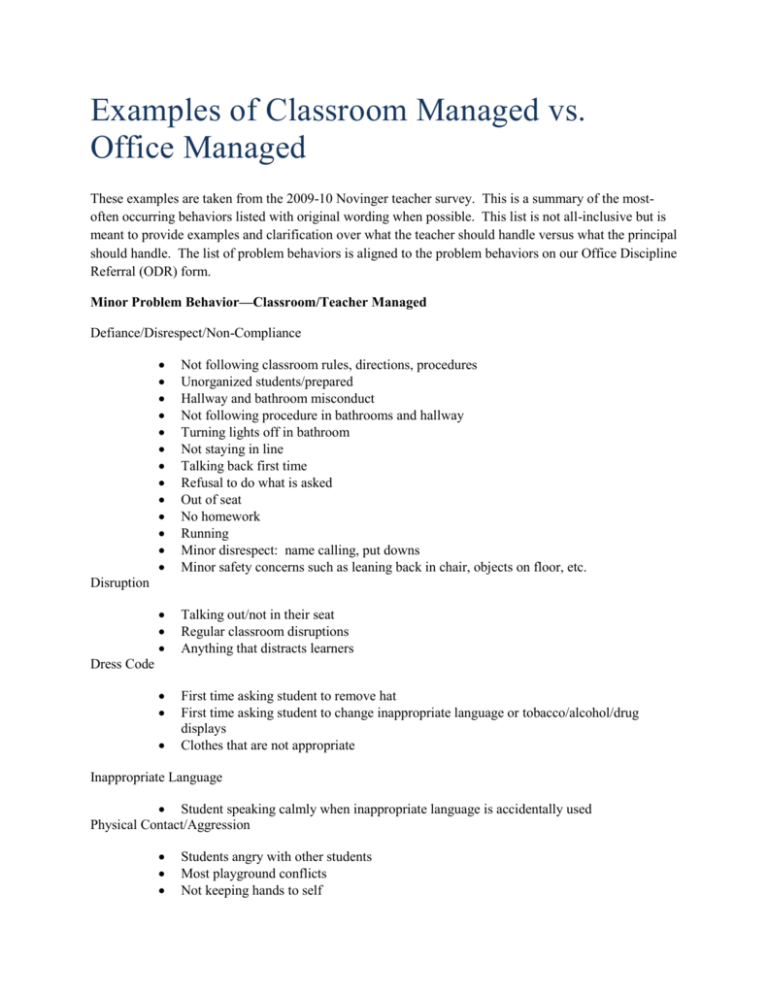
Examples of Classroom Managed vs. Office Managed These examples are taken from the 2009-10 Novinger teacher survey. This is a summary of the mostoften occurring behaviors listed with original wording when possible. This list is not all-inclusive but is meant to provide examples and clarification over what the teacher should handle versus what the principal should handle. The list of problem behaviors is aligned to the problem behaviors on our Office Discipline Referral (ODR) form. Minor Problem Behavior—Classroom/Teacher Managed Defiance/Disrespect/Non-Compliance Not following classroom rules, directions, procedures Unorganized students/prepared Hallway and bathroom misconduct Not following procedure in bathrooms and hallway Turning lights off in bathroom Not staying in line Talking back first time Refusal to do what is asked Out of seat No homework Running Minor disrespect: name calling, put downs Minor safety concerns such as leaning back in chair, objects on floor, etc. Talking out/not in their seat Regular classroom disruptions Anything that distracts learners First time asking student to remove hat First time asking student to change inappropriate language or tobacco/alcohol/drug displays Clothes that are not appropriate Disruption Dress Code Inappropriate Language Student speaking calmly when inappropriate language is accidentally used Physical Contact/Aggression Students angry with other students Most playground conflicts Not keeping hands to self Property Misuse/Damage Swinging on bathroom doors Writing on desks Standing on toilets Major Problem Behavior—Office/Administration Managed Abusive/Inappropriate Language Foul language Cussing out a teacher or student Language is specifically directed towards another person Defiance/Disrespect/Insubordination Disrespect for the teacher(s) Defiance-refusal to work at all Student who may have some sort of sexual material Refusal to do what is expected Defiant behavior Severe emotional outburst (tantrums) Students who consistently refuse to do what is asked Disruption Behavior that disrupts the entire class over a long period of time when the student cannot focus on the positive behavior asked of him (examples: screaming in anger, crying, hiding under table, running away) Fighting/Physical Aggression Fighting Violence Anger at others Physical abuse: fighting, biting, scratching Severe emotional outbursts (tantrums) Harassment/Bullying Bullying Cattiness Harassment Student who may have some kind of sexual material and is showing others who do not want to see Inappropriate Display of Affection Anything sexually inappropriate Sexual material Kissing Touching of bodies Lying/Cheating No examples were listed on survey except the word “cheating” on the teacher managed list. Although many teachers prefer to manage this, is it still written on the ODR as a Major Problem Behavior and sent to the office. Teacher may write what actions s/he took and that no other actions are necessary, but it still needs documented on the ODR. Out of Assigned Area Out of assigned area Leaving room without permission Requesting to go to an area and then going to an area not requested Property Damage/Vandalism Purposefully damaging and/or destroying school or others’ property Technology Violation Accessing websites that go again internet agreement Theft/Forgery Stealing items that belong to school or others Forging signature Plagiarism Truancy/Tardy Leaving school without permission Missing school without excusal Tardiness (School will determine how many tardies requires an ODR.) Safe School Act Violation Threats Students who might have some kind of weapon Legal issues Violence with weapons Major safety concerns A common suggestion on the survey was that repeat behaviors are recorded as specific problem behavior and are referred to principal. In general teachers will handle Minors and the principal with handle Majors, but there are times when that may need to be different. That is fine, but an ODR still needs to be submitted to the office with correct categories checked regardless of who actually handled the problem. Classroom Management Strategies (Adapted from Dr. Tim Lewis) 1. Increase ratio of positive to negative teacher to student interactions Maintain at least a 4 to 1 ratio of positive comments to corrective feedback Follow correction for rule violation with opportunity for positive reinforce for rule following 2. Actively supervise at all times Move continuously Scan continuously & overtly Interact frequently & positively reinforce rule following behaviors 3. Positively interact with most students during lesson Physical, verbal, visual contact Group v. individual Instruction & social 4. Manage minor (low intensity/frequency) problem behaviors positively & quickly Signal occurrence State correct response Ask student to restate/show Disengage quickly & early 5. Follow school procedures for chronic problem behaviors Be consistent & business-like Pre-correct for next occurrence 6. Conduct smooth & efficient transitions between activities Taught routine Engage students immediately 7. Be prepared for activity Know desired outcome Prepare filler activities and have materials read Practice presentation fluency 8. Begin with clear explanations of outcomes/objective Use advance organizer Provide point of reference for students 9. Allocate majority of time to instruction Effectively utilize time with instructional activities Maximize teacher led engagement 10. Engage students in active responding Write Verbalize Participate 11. Give each student multiple ways to actively respond Individual v. Choral Responses Written v. Gestures Peer-Based 12. Regularly check for student understanding Questions Affirmative gestures Written action 13. End activity with specific feedback Academic v. Social Individual v. group 14. Provide specific information about what happens next Homework New activity 15. Know how many students met the objective/outcomes through data Use a variety of assessment measures: oral, written, samples 16. Provide extra time/assistance for unsuccessful students More practice and additional instruction 17. Plan for the next time the activity is conducted Firm up outcome New outcome Test In Class Strategies & Problem Solving Tips Get to know your students well – what they need & what is the function of their behavior: Obtain peer attention Obtain adult attention Avoidance of peer Avoidance of adult Avoidance of task/activity Provoked by peers Once you know your students & have identified the function of their behavior, these strategies and problem solving tips will be helpful. Strategy 1: Teach, Practice, Re-teach Expected Behavior Use the same tone when teaching and reteaching social skills that you use when you are teaching reading, writing and math. It takes focus & can become challenging when you enter the re-teach and practice phases, but you can do it. Teach what you DO want the student to do, not what you don’t want them to do. Teaching your student what TO DO teaches him or her a replacement behavior. The replacement behavior must meet the same need the child had when making the behavior violation. Sample language, “To be safe in the classroom, we walk,” rather than, “Don’t run.” Reteaching can be done individually, in a small group or with the whole class. It should feel like a teaching experience vs. a punishment. If only a few students are not meeting expectations, it does not make sense to reteach and practice with the whole class. This takes away valuable time on learning tasks. Reteaching needs to happen at the time the student exhibits a problem behavior or very soon after. If at all possible, it should be done by the staff member that the student exhibited the problem behavior with at a time that works with his or her teaching schedule. Use role play to act out roles in social situations. Teachers must always act out the “nonexample.” Students do not need more practice doing it wrong. Choose students to act out the appropriate examples to provide practice. (Example: you get bumped in the hallway. The teacher acts out the non-example/inappropriate response to the bump.) Hold child accountable to the teachings. Strategy 2: Reinforce expected behaviors Give positive, SPECIFIC feedback consistently. Use “Cat Tracks” paired with specific feedback. (Help students understand the value of the cards & like specific feedback to language found on our behavior matrix.) Use pre-corrects. When replacement behavior errors occur, or are predicted, the teacher uses proactive structures to increase success and opportunities fir positive, specific feedback. (Example: When I call your table number, push your chair in quietly and walk to your line order spot, facing front, with your hands at your side.” Then select one student to demonstrate or demonstrate the expectation yourself.) Strategy 3: Interventions for Problem Behaviors Give students choices. (Love & Logic) Model appropriate behavior. (Demonstrating a problem-solving technique gives the child a chance to see how something might work.) Allow students to feel empowered. (Students need to resolve their problems and be left with a feeling of positive self-control, not a feeling that power has been imposed on them by an adult.) Privately correct behavior. (Remember to praise publicly and redirect as privately as possible.) Redirect the student. Rewind the action and “do over.” Praise the “almost there” behavior. Praise a nearby student. Offer assistance with work. Use proximity. When delivering a consequence for a choice made, deliver the consequence with compassion & empathy. (“I can see this is hard for you.”) Send a “power message.” (“What do you think you’re going to do?” I’d like to hear your ideas.”) Give them some possible problem solving strategies. (Offer a variety of choices, from bad to good, usually beginning with the poor choices. Each time you offer a possibility; have the child state what the consequence might be for that choice. Give the child the opportunity to do more thinking than you!) Practice appropriate actions. Assign a peer partner. Provide an alternate task – break tasks into smaller parts. Clearly state or restate expectations. Give pre-arranged hand signal. Assign line order or seating order and label. Change where the student sits, either at a table, desk, or carpet. Use incentives. Work on building a strong relationship with the child; give him or her some of your undivided time and attention. Give student a regular job in the classroom, increasing his feeling of value within you class community. Use personnel resources in the building: Penny Copelin (Principcal), Angela Guest (Counselor), Julie Howe & Angela Meintz (PBS Coaches) Increase supervision. Provide a private workspace, without ostracizing them from the group. Provide a restricted environment to allow for more accountability. (ex. you cannot move around the room without teacher permission.) Collect data on the success/lack of success of strategies. (Remember, you must base your strategy decision on what you have learned about the child. Then implement the strategy CONSISTENTLY over time, providing specific feedback to the child along the way.) Work to see the situation from the child’s perspective as well as your own. Creatively teach child how to communicate wishes, needs, and frustrations with words, in an acceptable manner. Celebrate successes! Tips for Creating Classroom Routines Consistency, Consistency, Consistency! Leads to Success! Establish and stick with routines that fit your teaching style. Kids like predictable situations where they know the routine and know the consequences. Use this checklist to give you ideas of routines that you may need to teach and practice, so that you have more time for teaching in the long run. Arrival Routines Entering the Classroom o What is the expectation for when and how students enter the classroom? (walking, no talking, hug the teacher, greet at the door, go to the seat, etc.) Backpacks o When and how should students hang up their backpack? Do they need to get everything out of it for the day? Coatroom/Lockers o Is there a limit as to how many people can be at the lockers at once? Lunch Boxes o Where should students put their lunch boxes in the morning so they are easily accessible for lunch? Notes from Home o Where should students put notes from parents? Friday/Monday Folders o When are where should students return Friday folders? Chairs o Will students need to get their chair off a stack? Will they do this before or after they put away backpacks? Attendance o How is attendance taken? Morning Work/Arrival Activity or Assignment o Will there be morning work on the student’s desks./Smart Board/overhead when they come in? Will they turn it in when they finish or will you go over it as a class? Tardy/Late Arrivers o What do students who arrive late need to do? Daily Routines Lining Up/Line Order o How and where will students line up? What will their line order be? How often will you changes the line order? Water Bottles o Where will students keep their water bottles during the day? What will students do if they want or need to refill their water bottle? Homework o Where should students put their homework? How will you check homework for completion? Grade? How will homework be returned to students? Missed Homework Assignments o How and when do students get homework assignments they missed due to an absence? Unfinished work o What should students do when they have unfinished work? What will the consequence be for your classroom? Completed Work Early o What should students do when they complete assignments early? Read? Write? Asking for Assistance/Getting Teacher Attention o Will student be able to ask other students for help? Ask three before you come to me? Raise your hand? Writing Name on Work o Will students need always write their first and last name? Class Number? Date? Top right corner? On the line provided? Snacks o What will your procedure for snack be? Will each student bring snack once a month for everyone to share? What will you do if people do not have snacks? Where will snacks be kept until snack time? Transitions from Whole Class to Small Group Activities o How do your students move in the classroom between large/whole class instruction to small group activities? Transitions from Whole Class to Partner Work o How do your students move in the classroom between large/whole class instruction to partner work? Transitions from Whole Class to Independent Work o How do your students move in the classroom between large/whole class instruction to independent work? Working Independently o What the expected procedures, rules, and behaviors when completing independent work? Partner Work o What are the expected procedures, rules, and behaviors when completing partner work? Working in Groups o What are the expected procedures, rules, and behaviors when working in small groups? Working at Stations/Centers o What are the expected procedures, rules, and behaviors when working in small groups? Working in Large group/Whole Class o What are the expected procedures, rules, and behaviors when working in large group/whole class? Pencil Sharpening o When will students sharpen pencils? How will they know when they can sharpen pencils? Getting More Materials o When and where may students get more materials (paper, scissors, books, etc.) Classroom Jobs o Will you have classroom jobs? What jobs will you have? When and how will students perform jobs? Agenda/Homework Assignments o When and where will students write down their homework assignments? Will parents have to sign off on homework? Lost and Found o Where will lost or found items be put that are from the classroom? Bathroom o What will your bathroom procedure be? Will you go as a class? Have students sign out and in? What are procedures if you have a bathroom in your classroom? Answering Phone/Welcoming Visitors o Who answers the phone? Do you want to have materials available to take a note? What do you or your students do when a visitor arrives? Individual Students RE-entry from Specialists, Nurse, Counselor, etc. o How do students who come back to class reenter without disturbing others? Who do they ask to learn what they should be doing? Correction Procedures o What do students do when corrected? What materials are needed? How will you teach? What do they do to leave? What behaviors do they need to display to reenter? Who, when, and how will students discuss their behavior and what they need to do in the future? Cell Phones, IPODS, other Electronic Devices o What are your expectations regarding the use of these devices in your classroom? Make sure that your rules/routines are in alignment with School-wide policies. Dismissal Routines Chairs o What will students need to do with their chairs at the end of the day? Stack? Put on top of desk? Coat Room/Lockers o When and how will students know they can go to the coat room/lockers? Backpacks o When will students get their backpacks? How will they know they have everything they need for the night? Homework o How will you assign homework? Remember the guideline is 10 minutes per grade level per night. Leaving the Classroom o Will students all leave at the same time? Will students have to tell you one thing they learned before they can leave? What will you expectations and routine be? Bus Riders o Will students sit at their seats until their bus is called? Will they line up at the door? Will they play a game until they are called? Walkers and Car Riders o Will students sit at their seat until walkers and car riders are classed? Will they line up at the door? Will they play a game until they are called?
